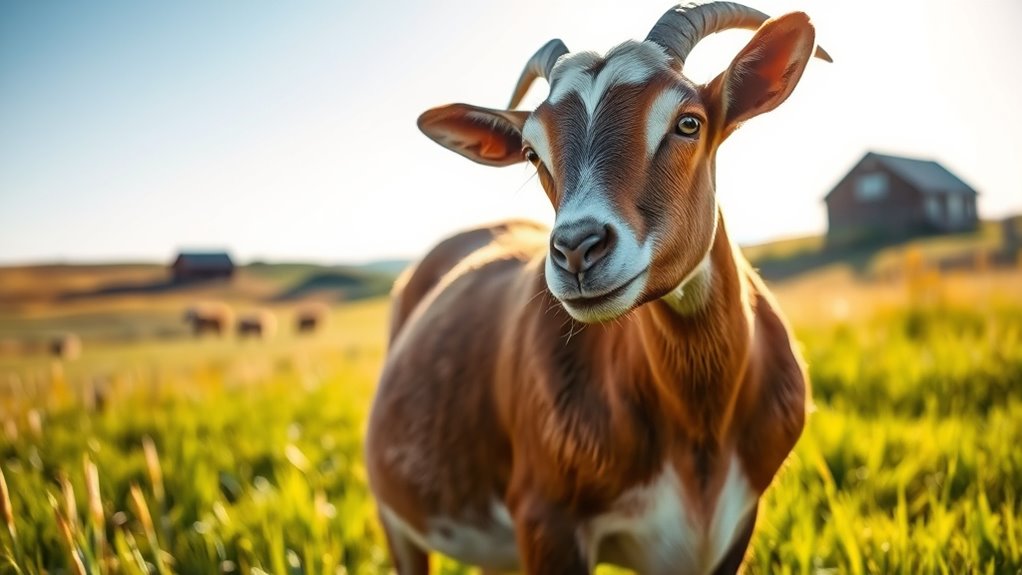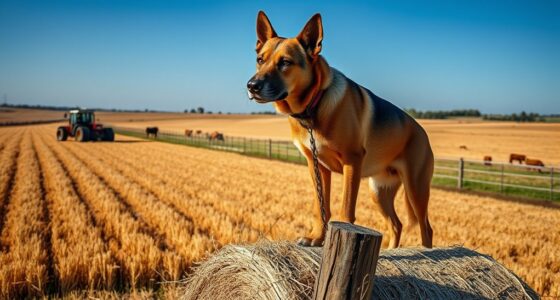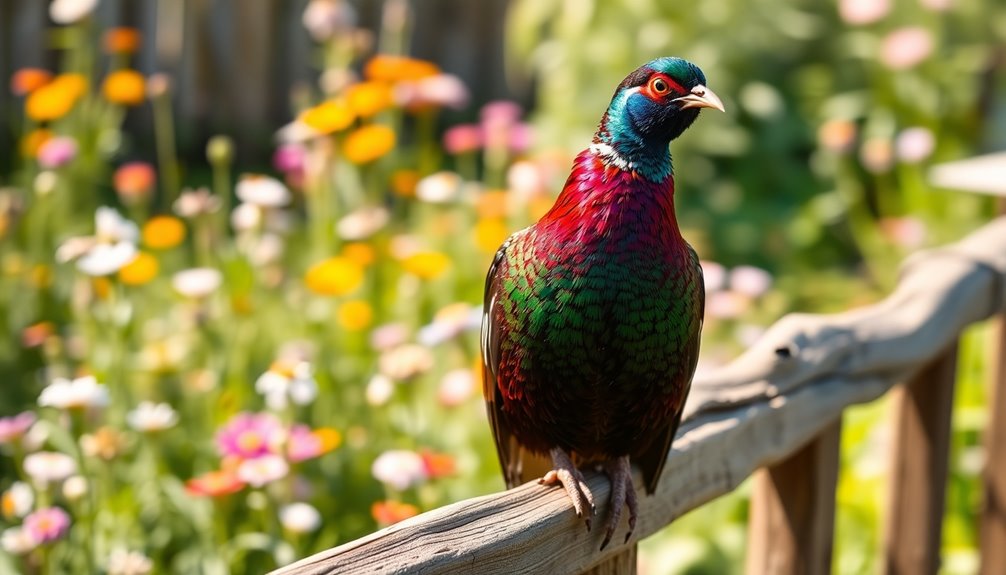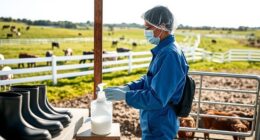Goats are pregnant for about 145 to 155 days, with the average gestation lasting around 150 days. Factors like breed size and nutritional needs can impact this timeline. Early signs of pregnancy might include weight gain and udder swelling, while the last month is critical for proper nutrition. Keeping a close eye on their health is essential for a smooth delivery. Stick around, and you'll discover more about caring for pregnant goats and preparing for their little ones.
Key Takeaways
- Goats have a typical gestation duration of 145 to 155 days, with an average of around 150 days.
- Smaller goat breeds may experience slightly shorter gestation periods compared to larger breeds.
- Most fetal growth occurs in the last third of the pregnancy, significantly increasing nutritional needs.
- Signs of pregnancy include weight gain, udder swelling, and behavioral changes after two weeks.
- Proper nutrition and health checks are crucial throughout the gestation period to avoid complications.
Understanding Goat Gestation Duration
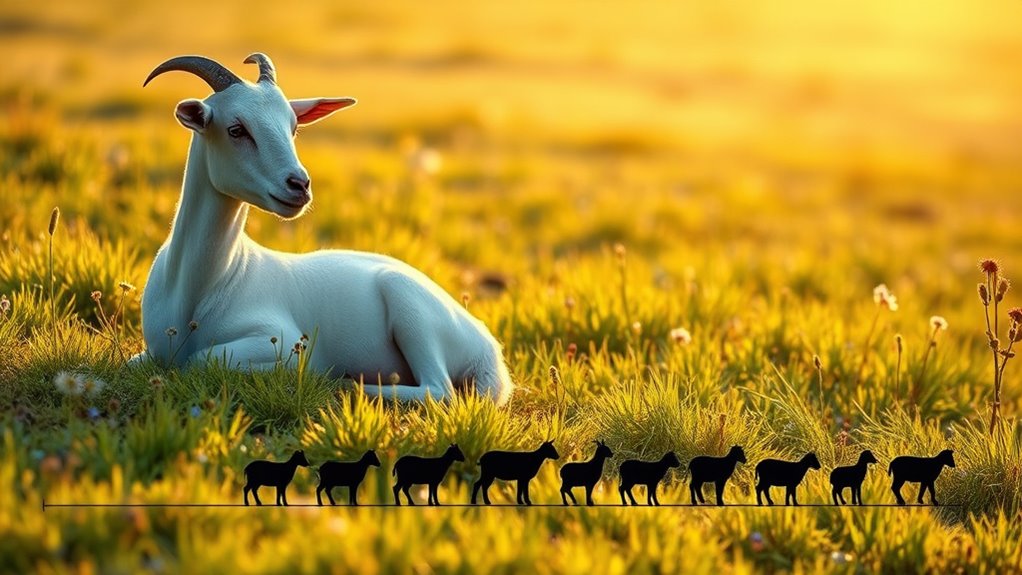
When you're looking into goat gestation, it's essential to know that the typical duration lasts between 145 to 155 days, with most goats averaging around 150 days.
Factors like breed size, the estrus cycle, and parity can influence this duration. For instance, smaller breeds may have slightly shorter gestation periods.
Proper nutrition is critical during this time, especially in the last month, as pregnant goats need a balanced diet rich in protein, energy, vitamins, and minerals.
You should also be mindful of health considerations, as conditions like pregnancy toxemia can pose risks, particularly with multiple fetuses.
Regular health checks help ensure a smooth gestation, so staying proactive is key to a healthy pregnancy for your goats.
Signs of Pregnancy in Goats
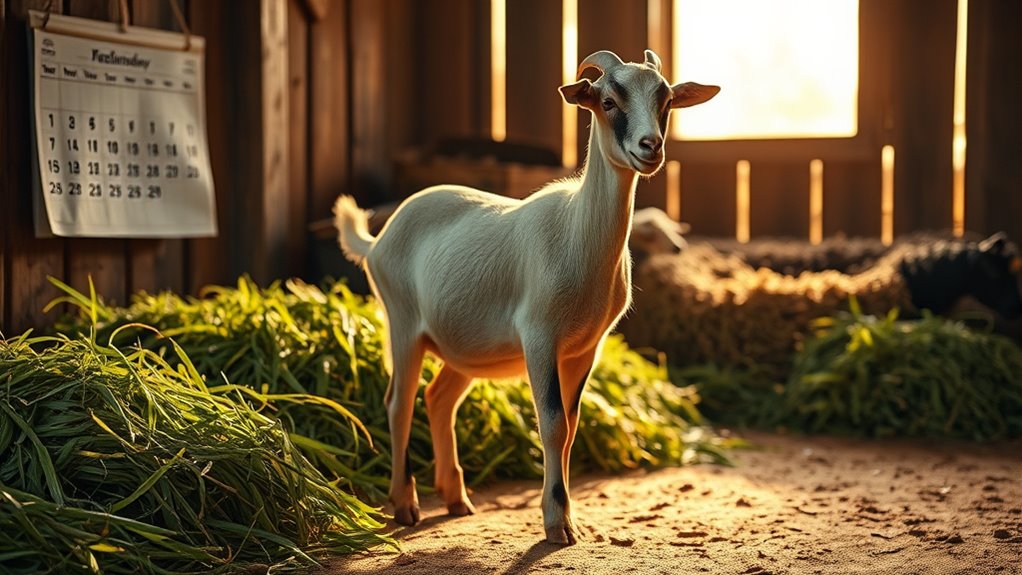
Recognizing the signs of pregnancy in goats is crucial for any goat owner, as early detection can help ensure proper care throughout gestation.
You'll notice physical changes like a tighter stomach and noticeable weight gain about two weeks after breeding. The udders may swell, especially in first-time does, and you might feel or see the kids moving around the four-month mark.
Behaviorally, does may act differently—becoming restless, more aggressive, or withdrawn. Keep an eye on appetite changes and vocalizations.
If your doe doesn't return to heat after her estrus cycle, that's a strong pregnancy indicator. As she nears labor, look for udder formation, vulva swelling, and signs of nesting behavior to prepare for the upcoming birth.
Nutritional Needs During Pregnancy
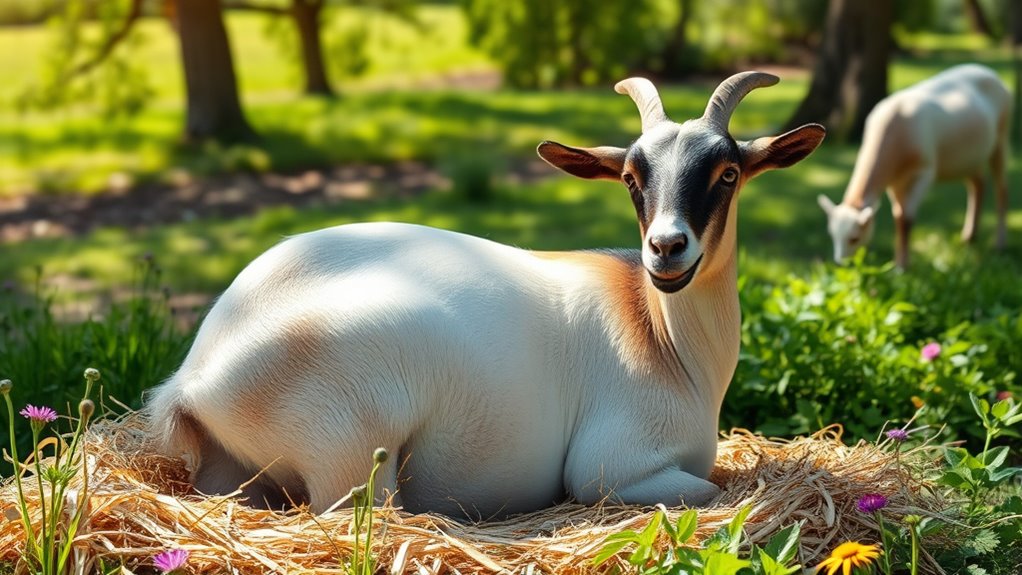
Pregnant goats have specific nutritional needs that evolve throughout their gestation period. In early gestation, their requirements are similar to maintenance levels, but as they approach late gestation, energy and nutrient demands spike, increasing by 50-75% depending on the number of fetuses.
Most fetal growth occurs in the last third of pregnancy, making protein and total digestible nutrients (TDN) critical.
Most fetal growth happens in the final third of pregnancy, highlighting the importance of protein and total digestible nutrients.
To meet these needs, provide high-quality hay, such as alfalfa, for calcium and protein. Use grain supplements sparingly and ensure fresh water is always available.
Mineral supplementation, including calcium, selenium, and phosphorus, supports fetal development and maternal health. Regularly monitor body condition and consult a veterinarian for tailored nutritional advice to avoid complications during delivery.
Health Considerations and Risks
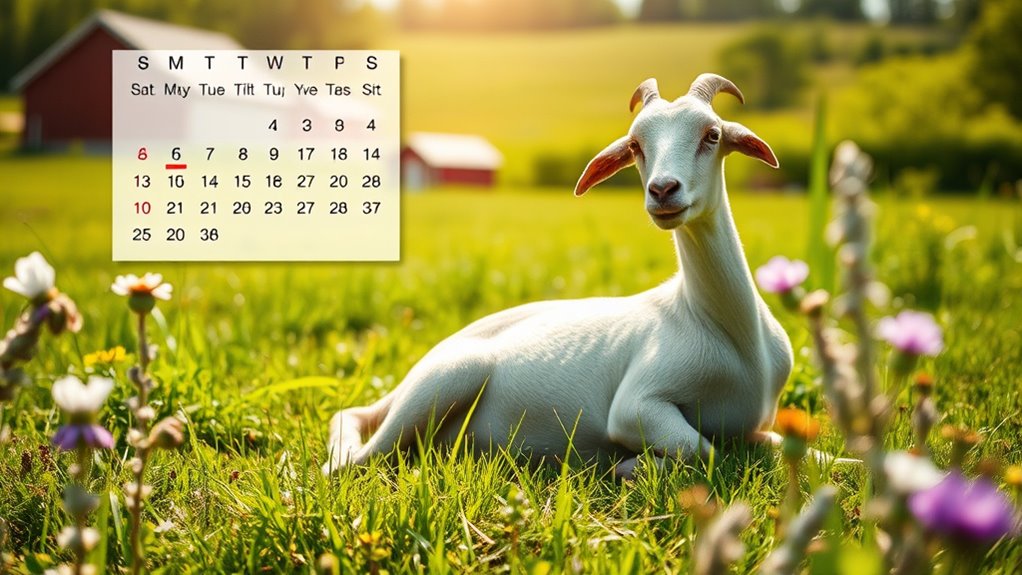
As goats progress through pregnancy, they're at risk for various health issues that can affect both the does and their offspring. Conditions like pregnancy toxemia and ketosis can arise from inadequate nutrition and increased energy demands, especially with multiple fetuses.
You'll notice symptoms like apathy and poor appetite, requiring immediate nutritional management.
Hypocalcemia, or milk fever, often strikes high-producing dairy goats, presenting stiffness and tremors that need urgent calcium treatment.
Vaginal prolapse can occur due to increased abdominal pressure, necessitating careful management to prevent recurrence.
Additionally, infectious abortions from pathogens can lead to significant pregnancy losses, emphasizing the need for good herd health practices.
Always consult a veterinarian for proper diagnosis and treatment of these conditions.
Preparing for Kidding
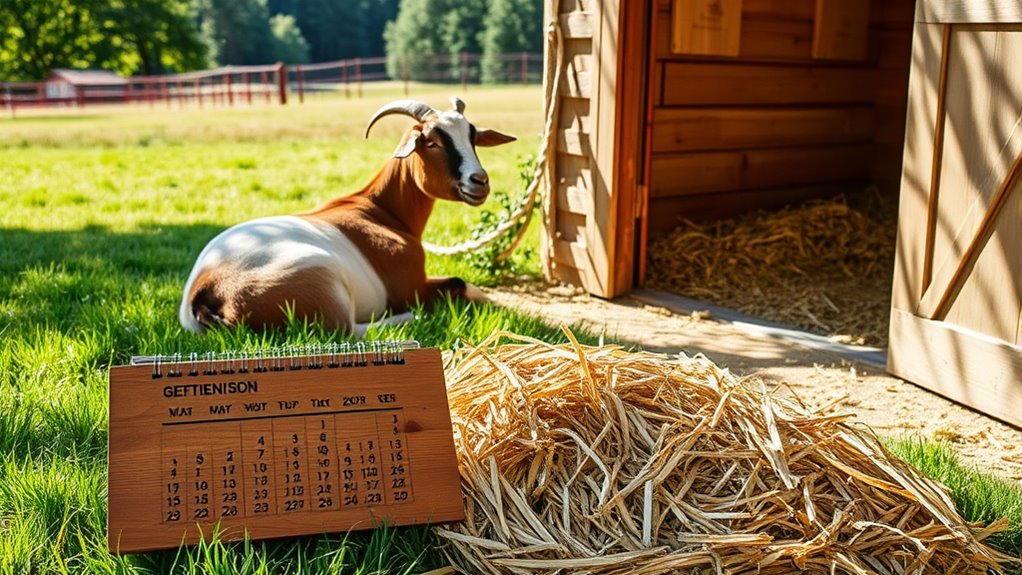
Preparing for kidding is crucial to ensure a smooth birthing process for your goats. Start by creating a clean, dry space, allowing 16 square feet for each newborn and 20-25 square feet for adults. Ensure good ventilation and bedding, and set up separate kidding pens for weak kids or reluctant mothers.
Next, prepare a birthing kit with towels, scissors, iodine, and sterile lubrication. Increase feed quality a month before kidding and vaccinate does with CD&T four weeks prior. Monitor your does for labor signs and understand the three stages of labor. Keep your veterinarian's contact handy for emergencies.
After birth, ensure kids nurse within hours and care for their umbilical cords to prevent infection. Regularly check the health of both does and kids.
Frequently Asked Questions
Can Goats Have Multiple Pregnancies in One Year?
Yes, goats can have multiple pregnancies in one year. You'll find that they can breed while still nursing, which allows for this possibility.
However, it's essential to manage their health carefully. Frequent breeding can put a strain on the doe, so ensure she gets adequate nutrition and health monitoring.
Keeping detailed records of breeding and kidding dates will help you plan better for future pregnancies and maintain her well-being.
What Breeds Have the Longest Gestation Periods?
If you're curious about which goat breeds have the longest gestation periods, you'll want to look at Toggenburg and Alpine goats.
Toggenburgs average about 151.7 days, while Alpines are close behind at 151.4 days.
Saanen goats also have a notable gestation length of around 150 days.
It's interesting to note that Granadina goats tend to have shorter gestation periods, averaging around 149 days.
Understanding these variations can help you plan better for breeding.
How Can Stress Affect Goat Pregnancy Duration?
Stress can be a silent thief, robbing your goats of a smooth pregnancy. It can lead to complications like miscarriages or prolonged gestation if not managed well.
You'll want to keep your pregnant does in familiar groups and provide a comfortable environment to minimize stress. Regular health checks and a balanced diet are essential too, ensuring that both the doe and her kids thrive throughout this critical period.
Are There Differences in Gestation for Dairy Versus Meat Goats?
Yes, there are some differences in gestation for dairy versus meat goats.
While the gestation length remains similar, dairy goats often need more energy due to milk production, affecting their nutritional requirements.
You'll also notice that health care plays a crucial role in both types to prevent issues like pregnancy toxemia.
What Is the Average Number of Kids per Pregnancy?
The average number of kids per pregnancy for goats usually ranges from one to three.
Most often, you'll find that does give birth to twins. Factors like breed, nutrition, and overall health can influence this number, so it's essential to ensure your goats are well-fed and cared for.
If you've got a first-time mother, expect her to have one or two kids, as they typically have smaller litters.
Conclusion
In conclusion, knowing how long your goats are pregnant helps you prepare for the miracle of life that's about to unfold—like waiting for spring after a long winter. By recognizing the signs of pregnancy, ensuring their nutritional needs are met, and staying vigilant about health risks, you can create a nurturing environment for both the kids and their moms. Embrace this journey, and soon enough, you'll be welcoming those playful little bundles of joy into your world!

